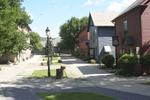Joe Wolfe Field
Joe Wolfe Field is a baseball field in North Adams, Massachusetts, United States. The field is home to the North Adams SteepleCats of the New England Collegiate Baseball League, a collegiate summer baseball league based in New England. The park was built in 1986, with the SteepleCats first utilizing the facility at their inception in the 2002 NECBL season. It has a seated capacity of 1,800 spectators, with additional seating and standing areas located down either foul line. The dimensions of the field are 325 ft. down the lines, 358 ft. in the gaps, and 385 ft. in dead center field. The park faces south in the Noel Field Athletic Complex. The field is lighted for night play with 8 light poles.In 2012, the Division III MCLA Trailblazers baseball team of the nearby Massachusetts College of Liberal Arts played three home games at Joe Wolfe Field. The facility is also used by the baseball teams of Drury High School and Charles H. McCann Technical High School, both located in North Adams. Joe Wolfe Field also hosts other youth sports leagues.
Excerpt from the Wikipedia article Joe Wolfe Field (License: CC BY-SA 3.0, Authors).Joe Wolfe Field
Oak Avenue,
Geographical coordinates (GPS) Address Nearby Places Show on map
Geographical coordinates (GPS)
| Latitude | Longitude |
|---|---|
| N 42.693228 ° | E -73.113 ° |
Address
Noel Field Athletic Complex
Oak Avenue
01247
Massachusetts, United States
Open on Google Maps






